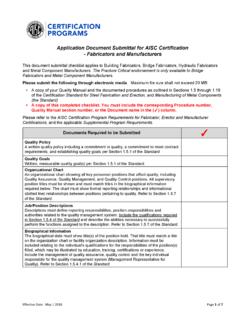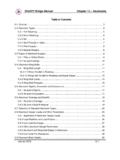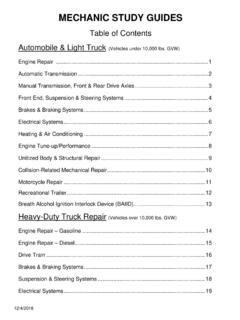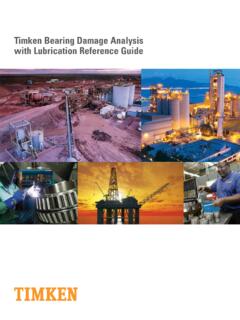Transcription of CHAPTER 6 Stringer Bridges and Making the Right Choices
1 CHAPTER 6 Stringer Bridges and Making the Right Choices Steel Bridge Design HandbookFebruary 2022 AISC 2022byAmerican Institute of Steel ConstructionAll rights reserved. This book or any part thereof must not be reproduced in any form without the written permission of the publisher. The AISC and NSBA logos are registered trademarks of information presented in this publication has been prepared following recognized principles of design and construction. While it is believed to be accurate, this information should not be used or relied upon for any specific application without competent professional examination and verification of its accuracy, suitability and applicability by a licensed engineer or architect.
2 The publication of this information is not a representation or warranty on the part of the American Institute of Steel Construction, its officers, agents, employees or committee members, or of any other person named herein, that this information is suitable for any general or particular use, or of freedom from infringement of any patent or patents. All representations or warranties, express or implied, other than as stated above, are specifically disclaimed. Anyone Making use of the information presented in this publication assumes all liability arising from such must be exercised when relying upon standards and guidelines developed by other bodies and incorporated by reference herein since such material may be modified or amended from time to time sub-sequent to the printing of this edition.
3 The American Institute of Steel Construction bears no responsibility for such material other than to refer to it and incorporate it by reference at the time of the initial publication of this in the United States of AmericaForeword The Steel Bridge Design Handbook covers a full range of topics and design examples to provide bridge engineers with the information needed to make knowledgeable decisions regarding the selection, design, fabrication, and construction of steel Bridges . The Handbook has a long history, dating back to the 1970s in various forms and publications. The more recent editions of the Handbook were developed and maintained by the Federal Highway Administration (FHWA) Office of Bridges and Structures as FHWA Report No.
4 FHWA-IF-12-052 published in November 2012, and FHWA Report No. FHWA-HIF-16-002 published in December 2015. The previous development and maintenance of the Handbook by the FHWA, their consultants, and their technical reviewers is gratefully appreciated and acknowledged. This current edition of the Handbook is maintained by the National Steel Bridge Alliance (NSBA), a division of the American Institute of Steel Construction (AISC). This Handbook, published in 2021, has been updated and revised to be consistent with the 9th edition of the AASHTO LRFD Bridge Design Specifications which was released in 2020. The updates and revisions to various chapters and design examples have been performed, as noted, by HDR, Grubb & Associates, Don White, , and NSBA.
5 Furthermore, the updates and revisions have been reviewed independently by Francesco Russo, , , Brandon Chavel, , , and NSBA. The Handbook consists of 19 chapters and 6 design examples. The chapters and design examples of the Handbook are published separately for ease of use, and available for free download at the NSBA website, The users of the Steel Bridge Design Handbook are encouraged to submit ideas and suggestions for enhancements that can be implemented in future editions to the NSBA and AISC at TECHNICAL REPORT DOCUMENTATION PAGE 1. Title and Subtitle Steel Bridge Design Handbook CHAPTER 6: Stringer Bridges and Making the Right Choices 2. Report Date February 2022 3.
6 Original Author(s) Ken Wright, PE (HDR) 4. Revision Author(s) Brandon Chavel, PE, PhD (NSBA) 5. Sponsoring Agency Name and Address National Steel Bridge Alliance, a division of the American Institute of Steel Construction 130 E. Randolph, Suite 2000 Chicago, IL 60601 6. Revision Performing Organization Name and Address National Steel Bridge Alliance, a division of the American Institute of Steel Construction 130 E. Randolph, Suite 2000 Chicago, IL 60601 7. Supplementary Notes The previous edition of this Handbook was published as FHWA-HIF-16-002 and was developed to be current with the 7th edition of the AASHTO LRFD Bridge Design Specifications. This edition of the Handbook was updated to be current with the 9th edition of the AASHTO LRFD Bridge Design Specifications, released in 2020.
7 8. Abstract Once a bridge type is selected, the designer then advances to the detailed design of the bridge. Since the vast majority of steel Bridges designed today are steel girders made composite with concrete bridge decks, this module covers many detail issues that are encountered when designing a composite deck girder system. This module addresses the design of welded plate girders. However, many of the principles presented are also applicable to the design of rolled beam Bridges . 9. Keywords Steel Girder Bridge, Span Arrangement, Steel Girder Design, Cross-Frames, Steel Detail Design 10. AISC Publication No. B906-22 i Steel Bridge Design Handbook: Stringer Bridges and Making the Right Choices Table of Contents INTRODUCTION.
8 1 SPAN ARRANGEMENT SELECTION .. 2 Assessing Superstructure Cost .. 2 Assessing Substructure Cost .. 2 Assessing Access Cost .. 3 Cost Comparison Summary .. 3 BASIC FRAMING DEVELOPMENT .. 5 Girder Economy .. 5 Redecking .. 6 CROSS-FRAME/DIAPHRAGM SELECTION .. 7 Spacing .. 7 Orientation .. 8 Frame Type Selection .. 8 GIRDER DESIGN .. 12 Selection of Appropriate Analysis Methods .. 12 Girder Depth Optimization .. 12 Girder Plate Transitions .. 13 Field Splice Location .. 16 Girder Web Design .. 17 Material Selection .. 19 DETAIL DESIGN ISSUES .. 22 Girder Cambers .. 22 Transverse Stiffeners Web Stiffeners .. 23 Transverse Stiffeners Connection Plates.
9 23 bearing Stiffeners .. 23 ii Longitudinal Stiffeners .. 24 Lateral 25 REFERENCES .. 27 iii List of Figures Figure 1 Graph showing typical bridge cost 4 Figure 2 Detail sketch of a typical K-frame cross-frame type .. 9 Figure 3 Detail sketch of a typical X-frame cross-frame type .. 9 Figure 4 Photograph of a full-depth plate diaphragm at the end of a span .. 10 Figure 5 Detail sketch of a typical Knocked-Down cross-frame .. 11 Figure 6 Sketches showing the slabbing and stripping process .. 14 Figure 7 Photograph showing a run-off tab .. 14 Figure 8 Diagram of a mixed steel I-girder .. 20 Figure 9 Diagram of a hybrid steel I-girder .. 20 Figure 10 Sketch of a longitudinal and transverse stiffener intersection detail.
10 25 iv List of Tables Table 1 Weight Saving Factor Per Inch of Plate Width for ASTM A709-Gr 50 Non-Fracture Critical Flanges Requiring Zone 1 CVN Testing .. 16 1 INTRODUCTION Once a bridge type is selected, the designer then advances to the detailed design of the bridge. Since the vast majority of steel Bridges designed today are steel girders made composite with concrete bridge decks, this volume will cover many detail issues that are encountered when designing a composite deck girder system. This volume addresses the design of welded plate girders. However, many of the principles presented are also applicable to the design of rolled beam Bridges . 2 SPAN ARRANGEMENT SELECTION When designing a plate girder bridge, the first and most important aspect of the design is to choose the proper span arrangement.














